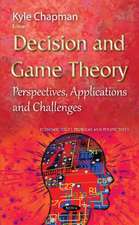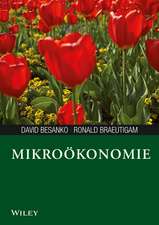From Catastrophe to Chaos: A General Theory of Economic Discontinuities
Autor J. Barkley Rosseren Limba Engleză Hardback – 29 iun 1991
| Toate formatele și edițiile | Preț | Express |
|---|---|---|
| Paperback (2) | 950.33 lei 6-8 săpt. | |
| Springer Us – 23 noi 2011 | 950.33 lei 6-8 săpt. | |
| SPRINGER NETHERLANDS – 22 ian 2013 | 1381.58 lei 6-8 săpt. | |
| Hardback (2) | 956.50 lei 6-8 săpt. | |
| Springer Us – 29 iun 1991 | 956.50 lei 6-8 săpt. | |
| SPRINGER NETHERLANDS – 30 iun 2000 | 1224.54 lei 6-8 săpt. |
Preț: 956.50 lei
Preț vechi: 1166.47 lei
-18% Nou
Puncte Express: 1435
Preț estimativ în valută:
183.05€ • 190.86$ • 152.13£
183.05€ • 190.86$ • 152.13£
Carte tipărită la comandă
Livrare economică 20 martie-03 aprilie
Preluare comenzi: 021 569.72.76
Specificații
ISBN-13: 9780792391579
ISBN-10: 0792391578
Pagini: 402
Ilustrații: XIV, 402 p.
Dimensiuni: 155 x 235 x 24 mm
Greutate: 0.76 kg
Ediția:1991
Editura: Springer Us
Colecția Springer
Locul publicării:New York, NY, United States
ISBN-10: 0792391578
Pagini: 402
Ilustrații: XIV, 402 p.
Dimensiuni: 155 x 235 x 24 mm
Greutate: 0.76 kg
Ediția:1991
Editura: Springer Us
Colecția Springer
Locul publicării:New York, NY, United States
Public țintă
ResearchCuprins
1 Discontinuity in Economic Theory and Economic Discontinuities.- 1.1 Some Initial Remarks.- 1.2 Discontinuity in the Large and in the Small.- 1.3 The Role of Perspective and the Identification of Discontinuities.- 2 The Mathematics of Discontinuity.- 2.1 General Overview.- 2.2 The Founding Fathers.- 2.3 The Bifurcation of Bifurcation Theory.- 2.4 The Special Path to Fractal Geometry.- 2.5 The Synergetics Synthesis.- 3 Discontinuities in Microeconomic Systems.- 3.1 General Equilibrium Aspects.- 3.2 Discontinuous Competitive Market Dynamics.- 3.3 Discontinuities in Imperfectly Competitive Markets.- 4 Speculative Bubbles and Crashes I: Irrational.- 4.1 Introduction.- 4.2 A Classical View of Irrational Bubbles.- 4.3 Mechanisms of the Speculative Mania.- 4.4 Mechanisms of the Speculative Panic.- 4.5 Varieties of Irrational Bubbles.- 5 Speculative Bubbles and Crashes II: Rational and Semi-Rational.- 5.1 Self-Fulfilling Prophecies as Rational Bubbles.- 5.2 When Are Rational Bubbles Possible?.- 5.3 Price Bubbles in Monetary Economies.- 5.4 Stochastic Rational Bubbles.- 5.5 The Empirical Observability of Bubbles.- 5.6 A Semi-Rational Bubbles Synthesis.- 6 Catastrophe Theory in Macroeconomics.- 6.1 Nonlinear Investment and Business Cycles.- 6.2 Hysteresis of Stagflation.- 7 Chaos Theory and Macroeconomics.- 7.1 Introduction.- 7.2 Sunspots and Regular Cycles in Overlapping Generations Models.- 7.3 Chaotic Cycles in Overlapping Generations Models.- 7.4 Variations on a Theme.- 7.5 Does It Really Exist?.- 7.6 Multiplicity, Indeterminacy, and Worse.- 8 Discontinuity and Capital Theory.- 8.1 The Capital Theory Controversies.- 8.2 Technique Clusters, Discontinuous Technology, and Steady-State Comparisons.- 8.3 But Continuity Does Not Guarantee “No Paradox”.- 8.4 On the Other Hand Paradox Can Cause Discontinuity.- 8.5 Schumpeterian Discontinuities and “Historical Reswitching”.- 9 Discontinuous Evolution of Urban Historical Forms.- 9.1 Introduction.- 9.2 Agglomeration and the Formation and Sudden Growth of Cities.- 9.3 Long Distance Trade and Instability.- 9.4 A Possible Synthesis: The Role of Technological Change.- 10 Discontinuities in Intraurban Systems.- 10.1 Some General Remarks.- 10.2 The Role of Transportation in Urban Structural Bifurcations.- 10.3 An Ecological View.- 10.4 Static and Dynamic Boundary Discontinuities.- 11 Morphogenesis of Regional Systems.- 11.1 The Continuous Flow Model.- 11.2 Evolution of Urban and Regional Systems.- 11.3 Self-Organizing Regional Morphogenesis.- 12 Perspectives on Economic and Ecologic Evolution.- 12.1 Historical Perspectives.- 12.2 Continuous vs Discontinuous Theories of Evolution.- 12.3 Hypercyclic Morphogenesis of Higher Level Structures.- 13 Ecosystems and Economics.- 13.1 Nonlinear Bionomic Dynamics.- 13.2 The Bioeconomics Synthesis.- 14 The Limits to Growth and Global Catastrophe Revisited.- 14.1 Neo-Malthusian Collapse Models.- 14.2 Renewable versus Non-Renewable Resources.- 14.3 Managing Potential Catastrophe.- 14.4 The Entropy Argument.- 15 Instability and Volatility of Foreign Exchange Rates.- 15.1 Introduction.- 15.2 The Standard Foreign Exchange Rate Model.- 15.3 Forecasting Failures of the Standard Model.- 15.4 Alternative Explanations of the Forecasting Failures.- 15.5 Collapsing Exchange Rate Regimes.- 16 The Discontinuous World Economy.- 16.1 Global Dualism and International Immiserization.- 16.2 The General Tendency of the World System.- 17 Summary and Conclusions: Leaping Across the Abyss.- 17.1 Is Economic Discontinuity a Good Thing?.- 17.2 A Few Questions About Our Approach.- 17.3 A Final Synthesis.- References.
Recenzii
'Those who teach mathematical economics, micro, macro, trade, or regional will find this book a valuable source of interesting examples together with references for further.' Journal of Economic Literature 30 1992








